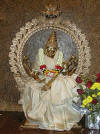|
Sarasvati (सरस्वती, สรัสวดี)
Sanskrit. The
Hindu
goddess of art and
learning,
and the consort of
Brahma
(fig.).
In
Mahayana
Buddhism, she is the goddess of education, music and poetry, and the
consort of
Manjushri.
In
China,
she is known as Biancai Tian (辩才天), i.e. the ‘Heavenly Eloquence’,
and Manjushri
as
Wen Shu
(fig.).
Her
mount is a peacock (fig.),
in Sanskrit known as
mayura
(fig.),
though in
Central Vietnam, i.e.
Cham art, she is
sometimes represented as seated on the
Hamsa (fig.),
and in
Myanmar
on its Burmese equivalent, i.e. the
Hintha (fig.).
In Indian
iconography,
she is
often portrayed
playing the
veena, i.e. a
sitar-like
(fig.)
stringed instrument.
In Thai, she is known as
Surasvati
(fig.)
and
Surasvati Devi.
In Tibet, she also has a wrathful emanation, which is known as
Vajra
Sarasvati or
Magzor Gyalmo in Tibetan, which translates as
‘Queen
of the Weapon Army’.
She is
an enlightened protector deity
in
Lamaism
and
in this
ferocious
appearance, she
is portrayed with a dark blue complexion, one face and two hands,
holding aloft a scepter in one hand and a
kapala,
i.e. a cup made from a human skull (fig.),
in the other. She wears a necklace of severed human heads and is
seated on a donkey (fig.).
Originally,
this Hindu goddess was a personification a
the river Sarasvati.
Matangi is the Tantric form of Sarasvati, who in her appearance as
Raja-Matangi (fig.), is also depicted playing the veena, but —unlike Sarasvati— in the company of a parrot (fig.). See also TRAVEL PICTURES (1) and (2).
回






|

